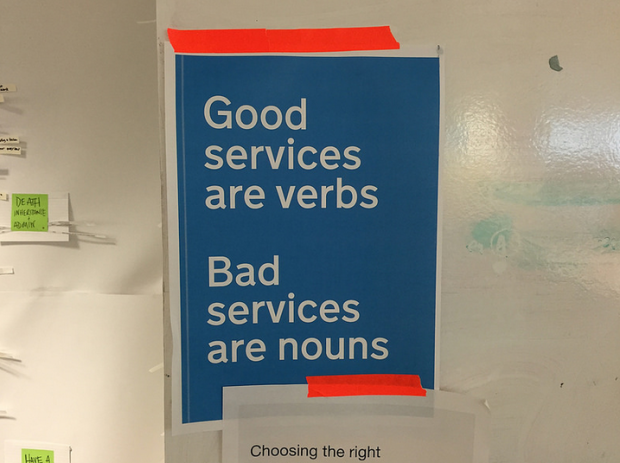
A few weeks ago I wrote a post on the design blog about what public services might look like in a world of government as a platform.
In a nutshell, platforms, open data, and shared components (the building blocks of government as a platform) will make public services easier to build, but won’t on their own make services better.
To do that we need to fundamentally change the way that services work in government, and find ways that we can build those services faster.
So we’re focussing on two things:
1. Re-setting the way that services work to be unified, cross department journeys
eg. buy a vehicle, import plants, dispose of waste, start a nursery etc.
(We’ve already made the first step towards this by changing the way that GOV.UK browse works.)
2. Creating standards for 'what good looks like’ for certain types of services
eg. getting permission to do something, exchanging the ownership of a thing, or delegating responsibility to someone etc.
We’re calling these ‘service patterns’ - consistent (but not uniform) standards for the way that a repeated activity (like getting permission) should work both for users and government.
Why use service patterns?
Like any other kind of standard, service patterns will provide better interoperability between services, meaning that we can more easily join them up across government.
Importantly though it gives government a way to know how to provide a particular type of service well.
Government services aren’t like other services, there is no established industry standard for, say ‘getting benefits’ in the same way as there is for ‘buying a mobile phone’, because government is often the only provider of that service. That means that anything we learn, we need to learn ourselves.
Given how many services do the same thing in completely different ways - and the long tail of those that don’t meet user needs - we need to find ways to change these services faster. Service patterns will be our instruction manual for using platforms and registers to build better services.
As Matt Edgar wrote recently, most of government is mostly service design most of the time. Sadly, a large chunk of this effort is spent reinventing something that has already been done before. By creating standard patterns for services we can significantly reduce the amount of effort it takes to redesign a service well, allowing teams to concentrate on the things that are unique to their service.
What is a service pattern?
We’re still working out how the creation and management of a service pattern works, but we think these patterns are likely to provide a template for how to build a particular type of service, alongside a set of components to build that service with, including:
- A consistent user journey
- A consistent internal process
- A set of standards (that cover when, where, and how that user journey and process should work)
- A set of modular components that can plug together to build this journey (including common registers, platforms, and reusable code)
Most importantly, these patterns will need to evolve constantly, fed by the experiences of those using and testing them in the field - in the same the way that the GOV.UK interaction patterns have grown and evolved over time.
What we’ve learned in discovery
To see if creating standard service patterns was even possible, we worked with departments and agencies across government to look at three service patterns, doing user research across a broad spectrum of services to understand patterns in:
- Getting permission to do something
- Exchanging the ownership of a thing
- Getting funding
It confirmed our assumption that there are huge areas of similarity in these services that do these things - for example we found over 300+ licences that required same process, but were delivered in completely different ways.
With users too, there were huge similarities in their needs around these things, regardless of what item they were exchanging the ownership of, or why they needed a licence.
Still lots to do
There’s still a lot to work out, but this is a useful starting point for finding out what we need to do to change the way that services work in government, and build those services faster.
Follow Louise on Twitter, and don't forget to sign up for email alerts.


4 comments
Comment by Yasin Abbas posted on
Hi Louise.
Does this differ from streamlining processes in BPM(N 2.0) (and exporting and identifying standard patterns there)?
Comment by Peter Jordan posted on
Hi Louise. As we've discussed a bit previously, performance measurement is an important element, which should be a part of the 4 components, or identified as a 5th.
* Identifying what good looks like and the data points to collect to demonstrate it
* What range of data should be collected (quant/qual, online/offline)?
* Measuring the complete journey - from findability to GOV.UK to service completion
* Benchmarks
* Data stories and visualisation
Comment by Chris Thompson posted on
The sooner we can get this in place the better. There's lot of opportunities here in terms of efficiency and getting rid of siloed thinking. We've already made some strides here to combat this in the Skills Funding Agency. I'm hopeful we can do more of this as we engage across other government departments. Please, please, please can we come up with a common identity management / assurance service?
Comment by Michael Lithgow posted on
This is a great approach. It recognises the citizen as being at the centre of the design of services, it focuses on delivering services differently, builds in constant improvement which supports agility and identifies where re-use will save time (and cost).